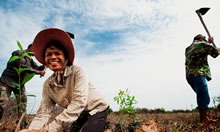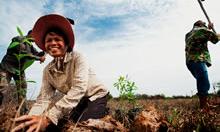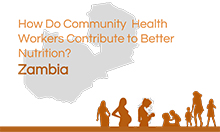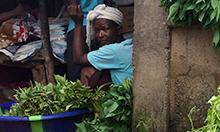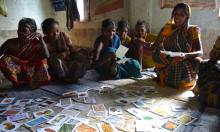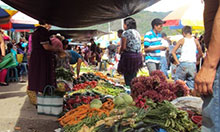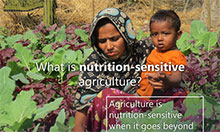Review of Approaches and Experience in Three Development Activities
Executive Summary
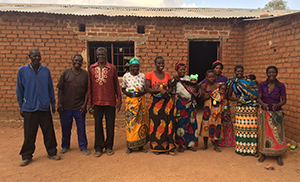
The SPRING Project, together with select nongovernmental organizations operating in Zambia, conducted a technical review of three agriculture and food security activities that have documented results in nutrition-sensitive agriculture. These activities and respective lead implementing agencies are Mawa (led by Catholic Relief Services (CRS)), Realigning Agriculture to Improve Nutrition (RAIN/RAIN+, led by Concern Worldwide), and Feed the Future Production, Finance, and Improved Technology Plus (PROFIT+, led by ACDI/VOCA). These three agencies have documented successes as well as challenges in implementing nutrition-sensitive agriculture interventions; both kinds of experiences collectively present a considerable opportunity for learning and evidence gathering in this growing field. SPRING conducted a systematic review of the key learning points from these three distinct activities, with the following objective:
Document the approaches and lessons learned from these activities, and share successes, challenges, and recommendations for future design, implementation, and monitoring & evaluation of nutrition-sensitive agriculture programs.
SPRING’s review consisted of a desk review of activity documents—prior to developing qualitative data collection instruments—and a three-week in-country field visit. During the field visit, SPRING conducted focus group discussions with activity beneficiaries, key informant interviews with activity staff and other stakeholders, and a stakeholder workshop at the end of the data collection period to discuss and validate preliminary findings.
The findings section of the report details key successes and challenges the three activities had in implementing nutrition-sensitive agriculture as analyzed along the three main agriculture-to-nutrition pathways that have agricultural production, agricultural income, and women’s empowerment as their starting points. According to beneficiaries and stakeholders, all three activities were successful in increasing the quantity and diversity of agricultural production, which supported increases in the quantity and quality (diversity) of foods consumed.
Activities’ promotion of nutrition messaging and the implementation of gender strategies to enable women to engage in the activities’ work to the benefit of their own and families’ health and nutrition likely contributed to this reported success. Among the challenges faced in all three activities were problems with water access for crop production, the high cost of farming inputs that outpaced gains in income from sale of agricultural commodities, and insufficient marketing support and ability to mitigate against market price fluctuations.
This review concludes by offering a number of recommendations to help future agriculture investments in Zambia better collaborate with, complement, and leverage one another to achieve donors' and the government’s food and nutrition security goals. Building on the successful approaches of Mawa, RAIN/RAIN+, and PROFIT+, and considering some of the key barriers they encountered in implementing nutrition-sensitive agriculture, SPRING recommends that future programming:
- build smallholder farmer resilience;
- integrate appropriate nutrition-specific and/or sensitive messaging;
- develop sustainable access to farm inputs and market linkages;
- adapt interventions to specific community contexts;
- select crops strategically to mitigate against over-production and market saturation;
- promote diversification and include animal source foods (ASF);
- explore investment opportunities in animals and ASF value chains;
- integrate nutrition messages in community finance schemes;
- build capacity of small and medium agro-processors and facilitate linkages with producers;
- continue to strengthen and expand locally-owned small and medium enterprises (SMEs);
- continue to stress the importance of workload sharing within the household; and
- continue to promote the concept of pamodzi (working together or doing things together) and greater gender equity.
Background
The SPRING Project, together with select nongovernmental organizations operating in Zambia, conducted a technical review of three agriculture and food security activities that have documented results in nutrition-sensitive agriculture. These activities and respective lead implementing agencies are Mawa (led by Catholic Relief Services (CRS)), Realigning Agriculture to Improve Nutrition (RAIN/RAIN+, led by Concern Worldwide), and Feed the Future Production, Finance, and Improved Technology Plus (PROFIT+, led by ACDI/VOCA). These three agencies have documented successes as well as challenges in implementing nutrition-sensitive agriculture interventions; both kinds of experiences collectively present a considerable opportunity for learning and evidence gathering in this growing field.
SPRING received funding from the U.S. Agency for International Development (USAID) Bureau for Food Security to undertake reviews of promising practices for linking agriculture and nutrition. Together with Mawa, RAIN/RAIN+ and PROFIT+, and with the support of the USAID Mission in Zambia, SPRING conducted a systematic review of the key learning points from these three distinct activities, with the following objective:
Document the approaches and lessons learned from these activities, and share successes, challenges, and recommendations for future design, implementation, and monitoring & evaluation of nutrition-sensitive agriculture programs.
SPRING hopes the technical review can be useful to practitioners, funding agencies, and the research community that have been building the evidence base, especially in the implementation of the U.S. Government’s Feed the Future initiative1 and its new Global Food Security Strategy (GFSS).2
Overview of Activities
Malnutrition remains a serious concern in Zambia, with 40 percent of the children under five years of age affected by chronic undernutrition or stunting, and 6 percent of the children under five years of age suffering from acute malnutrition.3 The Global Hunger Index (GHI) identifies the food situation in Zambia as alarming.4 The situation in Zambia has resulted in millions of dollars of program funding in 2017 alone to try to address the nutrition problem.
One such investment is the USAID Feed the Future Mawa Activity (2012–2017) led by CRS. Mawa operates in Chipata and Lundazi Districts of Eastern Province and its stated goal is to improve food and economic security in vulnerable smallholder farmers, particularly women, and households with children under two years of age. Please see table 1 for a snapshot of the activities we reviewed. Mawa aims to achieve this goal through diverse agricultural production, promotion of improved health and nutrition practices, facilitating the formation of Savings and Internal Lending Communities (SILCs), and gender integration. According to activity reports, the activity has contributed to diversified agricultural production, increased yields, and increased dietary diversity scores among children and within the household. Mawa’s annual surveys document positive results on some of the key determinants of nutrition from their multi-sectoral approach, which included a focus on positively influencing gender dynamics that affect agriculture and nutrition outcomes.5
Table 1. Snapshot of Activities
| Activity | Feed the Future Mawa | Realigning Agriculture to Improve Nutrition (RAIN)/RAIN+ | Production, Finance, and Improved Technology Plus (PROFIT+) |
|---|---|---|---|
| Locations | Chipata and Lundazi districts | Four wards in Mumbwa District | Chipata, Lundazi, Petauke, and Katete districts, peri urban Lusaka |
| Donor funding | USAID, US$9.6 million | Irish Aid, Kerry Group/Ireland, approximately 3 million euros; RAIN+ funded by Department for International Development (DfID), £1.4 million | USAID, US$24 million |
| Years | 2012 2017 | 2011 2015; RAIN+ extends to 2018 | 2012 2017 |
| Goals | Improve food and economic security in vulnerable smallholder farmers, particularly women, and households with children under two years of age | Develop a sustainable model that integrates and realigns agriculture and nutrition/health interventions to effectively prevent child and maternal undernutrition among poor rural communities that can be replicated and brought to scale to contribute to the achievement of MDG1 | Increase food security and decrease hunger through agriculture led growth and inclusive market access by smallholders |
| Focal agricultural commodities, including livestock and poultry | Diverse food crops such as maize, soybeans, groundnuts, sunflower, vegetables, small animals | as maize, soybeans, groundnuts, sunflower, vegetables, small animals 19 different varieties of garden vegetables, some goats and chicken | Maize, soybeans, groundnuts, sunflower, tomato, and onion value chains |
The Realigning Agriculture to Improve Nutrition (RAIN) Activity in Mumbwa District was a research activity implemented by Concern Worldwide and the International Food Policy Research Institute (IFPRI) from 2011–2015.6 It aimed to develop a sustainable agriculture-nutrition model to prevent undernutrition, and it reached around 4,400 households in one district. The activity used a multi-sectoral approach to improving nutrition by combining interventions on nutrition behavior change, women’s empowerment, and the promotion of diverse food production. The activity’s impact evaluation showed consistently positive impacts on agricultural production and household food security (in terms of food availability, access, and utilization) working through women’s groups and group leaders who received training from agricultural extension officers and activity staff who then passed on the information and skills to their group members. Agricultural interventions included the promotion of homestead gardening with a wide variety of crops including orange-fleshed sweet potato, iron and zinc biofortified beans, cowpeas, groundnuts, indigenous vegetables (Impwa, Amaranthus, Cleome) and other vegetables, in combination with nutrition behavior change communication and gender sensitization at the community, group, and household levels. A second phase of RAIN, RAIN+, which does not have the research component, is currently being implemented (2015–2018) with a focus on developing markets for nutritious foods and women’s empowerment as pathways to improve nutrition.
A third investment was the market systems development activity Feed the Future Production, Finance, and Improved Technology Plus (PROFIT+) led by ACDI/VOCA, which was designed as a value chain activity but later collected data that documented gender empowerment and nutrition-related outcomes. The objectives of PROFIT+ were to improve smallholder productivity, create greater access to markets and trade, and increase private sector investment in agriculture. Crosscutting objectives were to improve gender equality, increase food security, reduce poverty, and environmental compliance. A major activity was to promote a network of community agro-dealers (CADs). PROFIT+, in their final year, recorded several nutrition-sensitive agriculture outcomes among the CADs, such as increased incomes and production of nutritious crops, improved joint decision-making within the CAD households, and reductions in women’s workload.7
Geographically, both Mawa and PROFIT+ covered the Chipata and Lundazi Districts within the Feed the Future Zone of Influence, with PROFIT+ additionally covering Petauke and Katete Districts as well as peri-urban Lusaka. RAIN/RAIN+ meanwhile has activities only in Mumbwa District. Annex 1 presents a matrix containing the strategies and interventions used by each of the three activities.
The three activities were each working towards different sets of objectives and sub-objectives with different targeted beneficiaries. Mawa targeted vulnerable smallholder farmers, particularly women; RAIN+ targeted households with children in the first 1,000 days; and PROFIT+ targeted smallholder farmers. The PROFIT+ design is especially different from the other two as it utilized a market systems approach and did not include a mandate to improve nutrition. The purpose of this assessment is not to compare outcomes of the three activities but rather to understand how their overall design contributed to changes in nutrition among their beneficiaries.
Methodology
SPRING conducted this review in two phases: a desk review of secondary documents (see list of documents in Annex 2), including reports and plans of each of the three activities, and field data collection in country via focus group discussions (FGDs) and key informant interviews (KIIs) (see Tools in Annex 3). We validated our interim findings through a stakeholder workshop in Chipata, Eastern Region.
Desk review. SPRING conducted a desk review of activity documents prior to travel to Zambia. This helped to inform the planning of primary data collection, informed development of FGD and KII tools, and provided context to the findings from the in-country assessment.
FGDs. We conducted 36 FGDs (14 with RAIN+, 11 with Mawa, and 11 with PROFIT+) with activity beneficiaries to assess individuals’ perceptions of the activities they participated in, noting perceived along the agriculture-to-nutrition pathways (Figure 1). With SPRING guidance, the respective implementers of each activity (CRS, Concern Worldwide, and former staff of ACDI/VOCA) purposively selected FGD locations to ensure representation across different wards and camps.8 The majority of FGD participants identified themselves as farmers. Many of the beneficiaries had additional responsibilities as front-line workers or volunteers. Over 50 percent of the FGD participants identified themselves as non-frontline workers/volunteers. See Annex 4 for the list of FGDs.
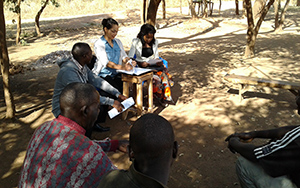
KIIs. We conducted 25 KIIs with key activity staff and stakeholders (industry, nongovernmental organizations, government agencies, and USAID staff) to explore overall strategies, activity successes and challenges, and best practices in program engagement and coordination. See Annex 4 for a list of individuals interviewed.
Data summary and analysis. The analysis of qualitative information collected via the FGD and KII responses was guided by the agriculture-to-nutrition pathways (figure 1). Each research team member coded FGD and KII responses into existing themes within an analysis matrix in MS Word. The research team highlighted, discussed and reached consensus on common themes within each pathway. We explored the extent to which stakeholders' perceptions or responses were similar to or deviated from each other by triangulating responses from the FGDs, KIIs, and the debrief workshop. Triangulation was done to assist us in identifying successes, challenges, and lessons learned from among the three activities.
Validation workshop. At the conclusion of fieldwork, we presented our preliminary findings during a half-day workshop with activity stakeholders including activity staff, government officers, private sector representatives, and USAID personnel. The workshop was an opportunity to solicit stakeholders’ feedback on the accuracy and validity of the preliminary findings.
The study team consisted of one consultant—a professor of nutrition from George Mason University—and three SPRING staff members from the agriculture-nutrition team: a research advisor, an agriculture advisor, and an activity officer. SPRING hired two local research assistants to support the team with local language translation during FGDs. We conducted the FGDs in English and in the local languages (Chinyanja, Tumbuka, Tonga or Kaonde) while most KIIs were conducted in English.
Figure 1. Conceptual Pathways Between Agriculture and Nutrition9
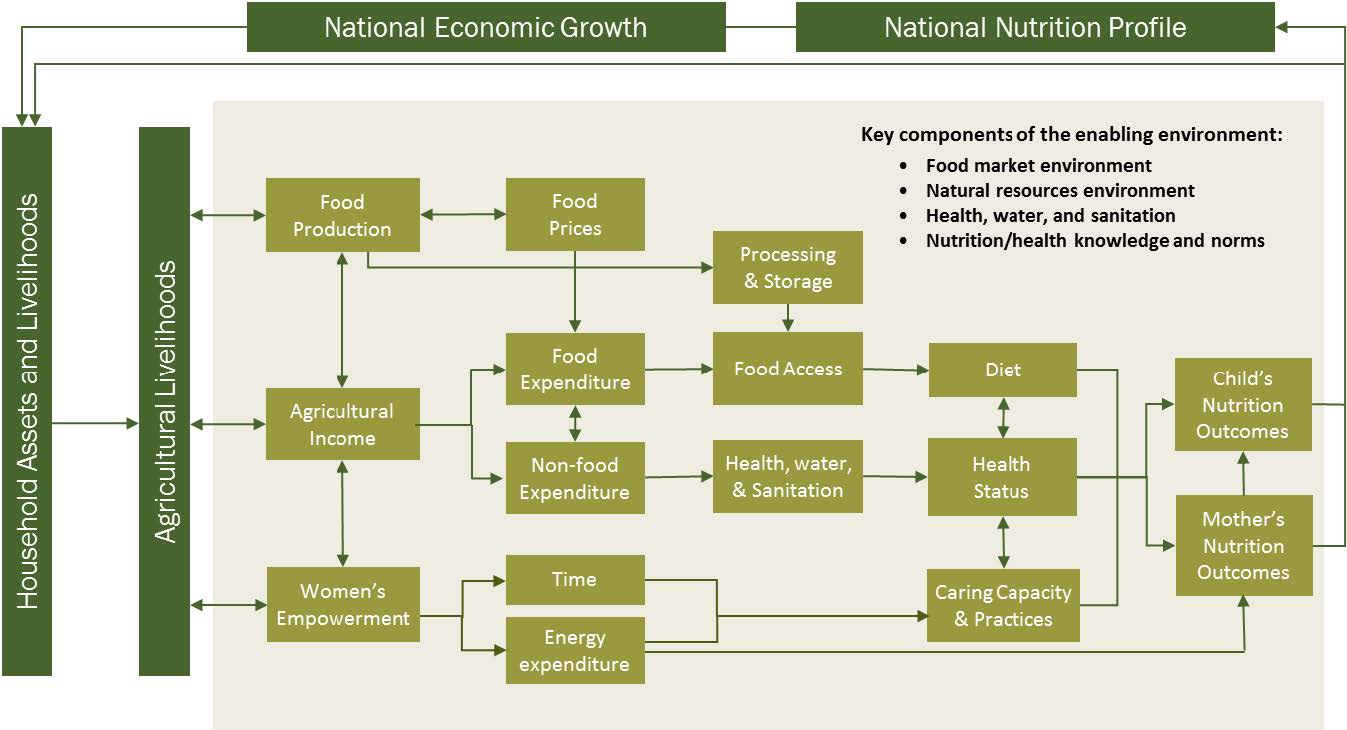
In the past we never used fertilizer in our crops. [Since] we’ve been using it, the issue of hunger has become a thing of the past. We learned how to use crop rotation, and using ripper to do ripping. No hunger now.
-PROFIT+ client
Since the activity, we have learned how to market, transport, bulk, maintain quality, use natural fertilizers (manure), and also sell to schools for school feeding (supplying bags of vegetables per week). No wastage for some. For others, excess vegetables are dried under the shade. This has cut down the hunger issue in the community.
-RAIN+ farmer
Study Limitations
The current review has the following limitations:
- Findings reflect study participants’ perceptions of change and not measured change in knowledge, behaviors, or practices.
- The review used convenience sampling in identifying FGD participants, creating the possibility of bias towards individuals who were especially active in the interventions themselves and are more motivated to participate.
- Approximately 50 percent of FGD participants identified as having a defined role on the activity and these individuals may have been biased towards reporting activity intentions as opposed to actual practices.
- While SPRING acknowledges that multiple communities interacted with more than one activity and perhaps stood to benefit from increased exposure, this review did not include analysis of the effects of overlaying interventions on nutritional status.
Findings
Building on our use of the agriculture-to-nutrition pathways for analysis, this section provides a discussion of the successes and challenges faced by the activities, organized according to changes in:
- food production to consumption;
- household income expended on food, health, and care purchase;
- women’s empowerment and joint decision-making: time, workload, and use of productive resources and income.
Where relevant, we also include lessons learned related to beneficiary engagement and multi-sectoral coordination and collaboration as they can either promote or hinder success in changing production, use of income, and women’s empowerment and should therefore help inform the design of future multi-sector nutrition interventions.
1. From Food Production to Consumption
Beneficiaries from all three activities reported a general increase in the amounts and types of foods that they produced across the different seasons, mainly due to increased crop yields, farmers’ abilities to plan for household food needs, increased utilization of food preservation methods, and improved post-harvest handling and storage.
Successes
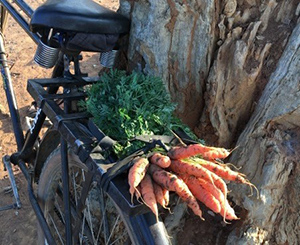
Food production diversity and quantity
All three activities promoted improved agricultural techniques aimed at improving yields while conserving natural resources. A majority of the activity beneficiaries reported that they had adopted conservation farming methods. Examples of conservation farming methods included ripping, basin planting, intercropping, crop rotation, and use of cover crops, while examples of organic farming methods included the use of organic manure and organic pesticides. Additionally, many beneficiaries used improved and certified seeds and planted fast-maturing crop varieties. While there were differences in the diversity of crops promoted by the three activities (table 1), all respondents stated that crop productivity had increased when compared to the pre-activity periods. Activity beneficiaries reported that hunger was no longer prevalent due in large part to increased yields and food preservation.
Beneficiaries across all three activities reported an increase in livestock numbers due to improved animal husbandry practices and increased income that supported increased livestock purchases and better care of animals.
None of the activities distributed livestock. However, Mawa actively promoted the construction of improved animal housing (goats and chicken), encouraged activity beneficiaries to seek timely veterinary services, and promoted raising a variety of small livestock. RAIN had a goat pass-on scheme in its early years as well as some distribution of chicken, however, mortality was high and coverage was not universal. PROFIT+ made veterinary products available through the CADs in Katete and Petauke.
The soya bean scraps are fed to the cows and the cows are now healthier than they have ever been. Even the groundnut scraps are given to the goats. The number of goats and cows has increased, not chickens. Chickens are given a mix of the soya beans and groundnuts and they find that they lay more eggs.
-RAIN+ farmer
Because of the vegetables we are planting, we are able to sell the excess and buy medicines for animals and take better care of the livestock.
-RAIN+ beneficiary
It’s because of Mawa, they taught us how to keep animals. When we had the money, we bought goats, but for the rearing of the animals, we learned to rear them.
-Mawa farmer
Food consumption diversity and quantity
Beneficiaries of all three activities reported that they produced crops for home consumption and sold the excess produce. Activity beneficiaries reported a general increase in the amount and type of foods they were consuming. Meal frequency increased, with beneficiaries across all three activities reporting that on average over the course of the year they consumed three to five meals per day compared to one to two meals before the activity. Because activity beneficiaries relied heavily on their own home production for dietary sources, the variety of foods within their diets tended to reflect the variety of crops that they produced. Beneficiaries of activities that promoted a more diverse list of crops such as fruits and vegetables reported consuming a greater variety of fruits and vegetables, including nutrient-rich produce such as orange-fleshed vegetables and orange maize. Additionally, they reported consuming more balanced diets10 than they did prior to activity interventions. For beneficiaries of Mawa and RAIN+, knowledge of the importance of incorporating multiple food groups into a meal came directly from nutrition lessons from the activity.
Animal source food (ASF) consumption was reported to have increased slightly. Examples of ASFs included meats and poultry, fish, eggs and sausages. Beneficiaries reported that they consumed milk only rarely. Beneficiaries reported consuming more eggs compared to pre-intervention periods and that eggs were now more frequently consumed compared to meats and dairy foods. Beneficiaries sourced eggs from both the market and within the home; many households choose not to consume eggs produced by chickens they own so that they can reproduce.
In the past the children just used to eat soup and never the meat. They only ate the soup. We even did not allow children to eat locusts. Since (the activity) came we feed our children caterpillars, termites, pumpkins. We even dry and grind pumpkin leaves and add it to porridge.
-Mawa farmer
They have not only introduced the new crops, they also introduced the new cooking methods at every stage and there is different way to prepare foods for children at different age.
-RAIN+ farmer
Activity beneficiaries continued to supplement their diets by purchasing food items they could not produce including oil (for those farmers that did not produce sunflower or groundnut oil), sugar, salt, bread, and vegetables. However, local food prices often affected what types and quantities of other foods they purchased.
SPRING collected information on infant and young child feeding (IYCF) and mothers’ diets from beneficiaries of the activities with nutrition components, Mawa and RAIN+. Beneficiaries of these two activities reported feeding newborn children colostrum, a practice that they only started adopting after receiving IYCF-related lessons and support from the activities. They also reported reduced provision of pre-lacteal herbal drinks and concurrent increase in exclusive breastfeeding compared to the pre-activity periods. Mawa and RAIN+ beneficiaries also reported increased diversity in the composition of children’s complementary food. The composition of children’s porridge in particular changed significantly.11 Parents of infants and young children reported that, unlike in pre-activity periods when children consumed plain maize porridge, they prepared porridge with added sugar, groundnut flour, vegetables, ground meats, eggs, and dry fish, among other additions. Beneficiaries attributed changes in food preparation to activity nutrition lessons, such as food preparation demonstrations.
Two notable diet-related changes reported among mothers were abandoning food taboos and consuming larger amounts of food. Activity beneficiaries reported abandoning previously held food taboos such as barring pregnant women from consuming eggs, catfish, doves, and honey. The second notable change was that women, especially pregnant women, were encouraged to consume higher amounts of food compared to pre-activity periods. Female FGD participants even reported support from their husbands in consuming more food. Additionally, their diets had become more diverse compared to pre-activity periods.
Participants reported no gender-based food restrictions or preferential treatment among young children and several noted that adult male preferential treatment was gradually fading away. Respondents attributed changes in household gender dynamics to the activities’ nutrition and gender lessons.
Challenges
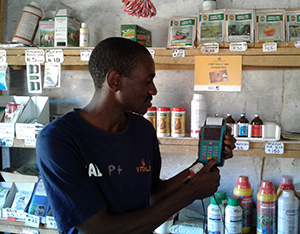
The following limitations continue to impact progress along the food production-to-consumption pathway.
Farmers rely heavily on rain-fed agriculture and thus face persistent water problems during the hot dry season (typically between September and November). This has made it difficult to maintain year-round vegetable production, including within home gardens. Some respondents report letting their vegetable gardens die off in the dry seasons. It is important to note that RAIN+ distributed handpumps to farmer groups, rehabilitated boreholes within their catchment areas, and encouraged their beneficiaries to dig wells within their homesteads.
While the beneficiaries acknowledge these changes, they report that the distance to the boreholes is still far. Despite increases in production diversity, existing water problems affect the year-round availability and diversity of foods, thereby affecting the nutritional status of mothers and children.
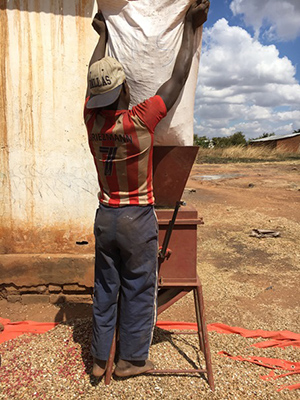
On-farm and processing equipment are still inadequate. Although some of the activities distributed rippers, handpumps and solar dryers, large groups of farmers (200–400 farmers) share these depending on the activity and the equipment, leading to delays in individuals accessing the improved technologies. Additionally, the cost of farm inputs, including seeds and fertilizers, continues to rise and is becoming prohibitively expensive. The cost of farm inputs has outpaced household income earnings, made worse by the current low prices for commodities. Farmers expressed difficulties in accessing farm inputs needed for the next planting season due to inadequate purchasing power, threatening both food production and food security at the household level. Farmers described the challenges of accessing inputs as primarily rising prices; the presence of a CAD meant farmers no longer had to travel to purchase inputs but often increases in incomes were not sufficient to meet the rising costs of goods.
Livestock deaths, especially poultry deaths, are still common. Some farmers suspect that chemical weed killers are to blame for increased livestock deaths in the Lundazi area. However, it is important to note that veterinary officers have not investigated or confirmed these claims. All three activities’ agricultural interventions focused heavily on crop production. Thus, there is a gap in addressing livestock production concerns among beneficiaries.
The assessment found that meat consumption is still low; 12 beneficiaries reported consuming meat one to four times per month. Activity beneficiaries report that they preferred purchasing ASFs over slaughtering their own livestock since livestock was a form of investment. Beneficiaries also described consuming ASFs such as field mice and caterpillar but not as a major substitute for purchased products. Thus, one’s ability to consume meat is linked more to purchasing power than household availability.
Really it depends on how much money you make. If you have made a lot, you can buy the meat and chicken. If you don’t have it then you wait.
-Mawa farmer
Key findings
- In order for increases in household food production (quantity and diversity) to lead to improved diets, interventions must also include intentional nutrition-specific programming, as seen in RAIN and Mawa. Where conditions are favorable for homestead food production—plots have good access to water and communities are relatively isolated from food markets—growing one’s own food is a sound household food and nutrition security strategy. In such circumstances, households prioritize family consumption, with obvious benefits in the quality of their diets.
- In more remote communities—defined by distance and/or poor road and bridge infrastructure—households struggle with marketing and selling their agricultural commodities. It is unrealistic to expect development activities to resolve this constraint unless resources are provided to improve roads. In communities that have the benefit of access to markets, households reported relatively fewer problems with selling, although they face uncertainties with prices. These households generally have better incomes, access to other foods they do not themselves produce, and access to seeds and other critical agricultural inputs. The CADs under PROFIT+ have somewhat solved issues with input availability; however affordability remains a constraint among many. Households that have better access to local food markets are better off in terms of options in selling and in purchasing food. Development interventions in communities that have better access to markets may focus more on market-led solutions, and alternative non-farm livelihood and business opportunities. Meanwhile, an activity that aims to target vulnerable households in more remote and isolated communities must pay greater attention to finding sustainable solutions for accessing key inputs and basic needs—water, seeds, fertilizers, and processing and preservation of nutrient-dense foods, including animal source foods—so they are able to produce, process, and preserve a diversity of foods for their own consumption.
- Economic growth investments in market systems and value chains as seen in PROFIT+ can include nutrition-sensitive agriculture actions and messages as value-added interventions. These do not have to be nutrition-specific messages or interventions (such as related to breastfeeding or complementary feeding practices). Agriculture activities can work with farmers and the enabling environment to produce more and better quality food, increase income and influence the way it is invested, and improve gender equity in terms of time use, labor, and use of agricultural resources.
- Homestead food production can and has been a successful way to achieve improved food security, however, it requires a stable supply of water, requiring a water pump and/or irrigation system, seeds, and access to markets. Kitchen gardens owned by Mawa beneficiaries suffered due to lack of water and the activity later introduced keyhole gardens intended to be fed by gray water from the kitchen during the dry season. RAIN+ emphasized water sources and invested in them leading to successful vegetable gardens. Successful PROFIT+ tomato growers we encountered had the benefit of a treadle pump.13
- If the objective of the development activity is food security (to sustainably increase the availability, access, and utilization of food), it helps to have a geographically focused approach as we observed in RAIN+: provide starter seeds for a wide variety of plants, solve the water issue, and provide consistent nutrition messaging, among many other actions. RAIN+ uses an implementation approach that is tailored to specific community contexts and employs short feedback loops so that the activity can regularly adjust implementation approaches to better meet the community’s needs. It helps when the target area is within one administrative district and activity interventions are comprehensive. Mawa is also comprehensive in its development approach however, unlike RAIN+, Mawa interventions covered a much larger geographic area with a lot more activity components. This has somewhat constrained the activity’s inherent flexibility and proactive ability to tailor to specific community contexts, which is a challenge in development activities implemented at scale and where feedback loops are less tight. For example, without a significant water component in some communities that we observed, Mawa's agricultural interventions were severely constrained. Community interventions therefore focused on the other activity components, which were done successfully.
- Animal source foods are an integral part of a comprehensive nutrition-sensitive agriculture strategy. Mawa introduced housing for small ruminants; however, animal production or veterinary services were not significant components of the food production strategy. Animal and crop production go hand in hand in food and nutrition security, and this seems to be a missed opportunity in all three activities, whether through homestead food production or investment in animal or ASF value chains. Households view animals as investments they can sell in times of need. This is a valid household food security strategy, and households can use the income from sale of their animals to buy and consume ASFs such as eggs, dairy, meat, and fish in local food markets. Indeed, we learned that as incomes went up while participating in the activities, households reported consumption of higher quality diets. Specifically, households purchased more ASFs.
2. Household Income Expended on Food, Health, and Care Purchase
Activity beneficiaries reported a general increase in household income compared to pre-activity periods. At the time of this review however, maize commodity prices were lower than the previous year, therefore this market-related challenge, coupled with rising costs of inputs, products and services, was a barrier to increasing expenditures on better food, health, care, and nutrition.
I feel the issue of money has become a lot better, as I joined the saving group. Unlike in the bank in town, there is an interest I earn when I save in the savings group. I’m able to buy goats, to keep them so that I can sell to pay for school fees for my children.
-PROFIT+ farmer
Successes
Most farmers reported that their incomes had increased across all activities, with the exception of the 2017 season when maize commodity prices dropped.14 Farmers reported the sale of excess produce as their primary source of income. Farmers also reported that their crop yields have increased since the activities were implemented, thus allowing them to keep enough produce for home consumption throughout the year and excess to sell for income. In fact, some farmers acknowledged that prior to participation in the activity they had not sold any produce due to poor crop yields.
Beneficiaries reported savings from Savings and Internal Lending Community (SILC) groups as another source of income. Beneficiaries of activities with strong SILC components were more likely to report “SILC share-outs” as a source of income.
Additionally, RAIN+ activity beneficiaries reported spending less on agricultural production costs, mainly due to increased use of available resources such as organic manure and pesticides for crop production. Beneficiaries of PROFIT+ and Mawa reported that the presence of CAD shops reduced the transportation costs associated with accessing agricultural inputs in Chipata and Lundazi districts.
Now we find it so easy to find seeds than it used to be. Before we had to travel to Lundazi and Chipata towns to get the seeds.
-PROFIT+ farmer
We are able to get hoes, and many other inputs with this shop now. The shop is kept well. The price here is the same as in town.
-PROFIT+ farmer
Across all three activities, priorities for household expenditures included farming inputs, school fees and other school-related requirements, home improvements, real estate investments, groceries (soap, sugar, salt, bread, oil in non-sunflower zones), and transportation costs. Activity beneficiaries reported that compared to the pre-activity period, it was now easier for them to purchase products and inputs and pay for services because of the increase in household income. However, beneficiaries were also keen to report that the cost of goods and services had outpaced income earned.
Households did not prioritize saving money for health care needs. One reason for this was that beneficiaries reported being healthier compared to the pre-activity periods and consequently reduced frequency of health care center visits. They attributed this change to reduced hunger, consumption of nutrient-rich foods, and improved care practices.
The second reason for not prioritizing saving for health care was summed up by a key informant: “Saving for health care is a not a Zambian thing.” Activity beneficiaries reported that free health care services are available through government health centers. They clarified that they only spent money on transportation costs to the health centers, on prescription drugs that may not be available at the health centers, and on maternity kits. However, increased household income had eased burdens associated with these costs. Although saving for health care was not common, members of one SILC group reported saving for health care emergencies through a social fund that is open to every member of the group and to which each member contributes a small agreed upon amount during every meeting.
Challenges
The farmers and key informants expressed the following challenges affecting their farm sales and income:
- the current oversupply as compared to demand, especially for maize, leading to low commodity prices
- high transportation costs to markets, especially in the more remote communities
- unscrupulous business practices, specifically, buyers tampering with weighing scales and buyers setting arbitrary prices that they are willing to pay for farmers’ produce
- delayed payments from the Food Reserve Agency and aggregating CADs
- poor market returns on (and lack of markets for) high quality produce like the organically-produced vegetables
- limited access to market information (real time market information to make selling decisions), particularly in the remote areas where the cost of bringing products to markets is the highest
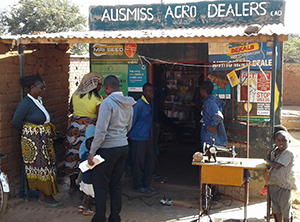
Activity beneficiaries noted that despite their increased incomes in previous years, prices of inputs, goods and services had continued to increase leading to a decline in their purchasing power. Further, many of the activity beneficiaries’ diets are constrained because the prices for commodities they produce are low and financing or storage technologies that may assist them in holding their product longer until prices improve are lacking. Additionally, the foods that smallholder families need to purchase in order to maintain a nutritious diet year-round tend to include higher priced food items such as meat and eggs. In general, reduced purchasing power also has the potential to impact farming practices, crop yields, and food availability and consequently individuals’ diets and nutritional status.
The current poor prices for maize affected those farmers who relied predominantly on the staple for their income (and food), while those with a more diversified portfolio of crops, especially vegetables such as tomato, onion, and rape, reported a better outlook. An over-reliance on staple crops—or any single value chain which might force smallholders to dedicate their land entirely to a monocropping system—increases their vulnerability to commodity market forces and places agricultural households at risk of losing all their agricultural investments in cases of severe price drops such as was experienced by maize farmers this year.
Liquidity constraints challenged commodity aggregation by CADs. Aggregators such as CADs collect staple grains, in particular, from smallholders and sell to larger buyers. Focus group participants in this assessment explained that due to low access to financing by the CADs, they could only pay smallholders after they, themselves, had received payment from the larger buyers. This forces the majority of smallholders—who have immediate cash needs at time of harvest—to sell to itinerant traders at distress prices. Additionally, large commodity buyers have set quantity and quality requirements that smallholders and CAD aggregators have difficulty meeting. While the concept and practice of establishing CADs under PROFIT+ appears sound, challenges to sustaining the business linkages for CADs—and the smalholder farmers who could benefit from their services—still exist.
Key findings
- Increases in income enabled households to purchase ASFs from local food markets. They were also able to invest in more animals, since raising animals is a profitable activity and a good way to increase access to ASF locally. Despite the lack of significant investment in animal production, nutrition messaging in the activities we reviewed encouraged the actual consumption of ASFs.
- Community-based savings and lending groups such as those promoted by Mawa and to an extent, PROFIT+, provide a vital function in money management and are useful vehicles to manage household cash flow. From our discussions, these groups mainly assisted in budgeting for farm needs such as purchase of agricultural inputs. We did not hear explicit linkages between household financial management and how they may lead to better food, care, and health resources within the household, such as schemes to finance water and sanitation facilities, or food preservation or value-adding technologies. The nutrition-specific messaging in Mawa and RAIN+ complemented and influenced decision-making within the household for nutrition, however we did not hear how money earned or saved can be directly used for nutrition, apart from increased purchase and consumption of ASFs as already mentioned.
- Cost savings on key agricultural inputs, whether from reducing dependence on external inputs or improving access to CADs, helps to sustain homestead food production, household finances, and self-sufficiency. Farmers should aim to reduce costs at the same time as they pursue productivity. The increasing cost of farm inputs takes away the gains from increased productivity and sales.
- Farm households, in the interest of stability and food and nutrition security, cannot rely on staple commodity production as a sole source of income. Dependence on a few crops exposes farmers to the risk of market price fluctuations, especially in open economies such as in Zambia. Diversified agricultural production, which includes both plants and animals, and ideally, other non-farm income sources as well, is more likely to ensure diverse sources of income, which, in turn, provides greater resilience for smallholder farmers in the face of potential stress and shock. Production diversity in agriculture at the household, community, district and/or regional levels is possible. For example, we learned that households in Mumbwa bartered with each other, and often this is more advantageous for households to achieve household food and nutrition security rather than facing low prices and market uncertainties.
- Marketing was a big issue that affected household incomes. We heard repeatedly how low commodity prices are the biggest threat that farmers face. PROFIT+ had tried to address this by linking producers and aggregators with a few large buyers such as Cargill and the World Food Program. The activity later emphasized the roles of many local small and medium enterprises, however, our respondents and informants expressed often that PROFIT+ ended too soon and that a lot more could have been done. There are many ideas on how to mitigate the impact of market price fluctuations, such as warehouse receipts and forward contracts, in addition to crop diversification; however time had run out for PROFIT+ to test or implement these ideas. Many respondents felt that the CADs need more time to be established and become sustainable in order to absorb market shocks, especially in Zambia’s open economy.
3. Women’s Empowerment and Joint Decision-making: Time, Workload, and Use of Productive Resources and Income
Each of the activities incorporated gender strategies into the design of interventions in order to support women’s empowerment, including more gender-equitable access to and use of household assets and productive resources. The Activity Strategies table in Annex 1 details the various approaches the three activities used that led to the findings described below.
Unlike before (the activity), we now know how to divide our time. The gender training has helped. The men are able to help. Before (the activity), you would be coming from the farm with your child on your back, with a load on your head. For him he only walks freely with only an axe. When you reach home he asks you to bring food. And to bring him fire to light his cigarette. After that he says let’s go back to the field. This has now changed.
-Mawa farmer
In the past, really, women are the ones who did cleaning, washing, we were never involved, since the activity came to teach us about sharing. I heard and I changed. I used to always leave my wife to collect woods while we leave the field, now I do that too together with my wife.
-PROFIT+ client
We’ve learned from the activity how to manage time. For example, my brick layer husband helps in the garden. He also helps in household chores, and to collect water.
-RAIN+ farmer
Successes
Women’s time and workload
Farmers had mixed responses when asked if the amount of work had changed since they started participating in the activities. Some respondents reported that the amount of work had stayed the same while a majority of them reported that the amount of work had increased, which has led to higher productivity and incomes during the good years. Beneficiaries mentioned that some of them were now putting larger pieces of land under cultivation than before. The amount of work reported varied by activity. For example, basin making, watering, and harvesting were time-consuming. On the other hand, use of chemical weed killers and rippers reportedly required less time compared to the traditional methods. Activity beneficiaries were quick to report that they were motivated to work harder due to the increased crop yields.
Despite the reported increase in work, beneficiaries also agreed that work had become easier for the following reasons:
- Increased use of labor-saving technology Technologies included hand-pumps, rippers and weed killers.
- Improved physical and mental health Beneficiaries across all three activities noted that they were healthier and had the physical strength and mental capacity required to successfully perform their daily task.
- Additional help -Beneficiaries across all three activities reported that family members, especially women’s husbands, were helping more in the farms and with household chores. This helped reduce the workload among women.
- • Improved time management skills - Beneficiaries also reported taking time to plan their chores and incorporate time for rest and meals. While some beneficiaries reported that these skills existed prior to the activities, some of the beneficiaries noted that the activities had trained them on time management and budgeting skills.
- Hired farm labor - Some activity beneficiaries reported that they could afford to pay for manual farm labor. Such payments were made either in cash or as in-kind (livestock or crop produce).
- Spousal support -Beneficiaries from all three activities reported that husbands were encouraging their wives, especially the pregnant women, to take some time to rest. Respondents attributed this practice to gender lessons and messages provided by the activities.
There is cooperation between husbands and wives sitting down to make budget. You see more children going to school. In the past, the husband will take grain to sell and may not bring cash back. The main budgeting message is mainly from the activity. They teach about gender, which is very wide. Women and children used to be quite suppressed.
-PROFIT+ client
Although men help with the household chores, the kitchen is still considered the females’ domain, while the farm is considered the males’ domain. However, there is more discussion and consultation amongst spouses and family members than before.
-Study key informant
Household decision-making
SPRING noted three main positive changes with respect to activity beneficiaries’ decision-making process:
- Joint decision-making is becoming a common practice, especially with respect to farm work, household chores and investment-related decisions. Furthermore, activity beneficiaries reported involving their children in the household decision-making process including budgeting, investments, farm work and household chores. Male participants were keen to report that joint decision-making allowed for shared ownership of the consequences of all decisions made. Including children in the decision-making process is believed to help instill discipline in the children. It is important to note that the concept of togetherness is not a new concept in Zambia. Zambia’s first president, Kenneth Kaunda, promoted the concept of working together, locally known as Pamodzi.
- Men have increasingly begun to trust women to manage money and engage in activities outside of their traditional roles. Women have traditional roles in the kitchen; attitudes are shifting among households as development activities—not just those observed in this review—continue to engage with both women and men. Men are more actively providing the space for women to take independent roles, such as owning animals, engaging in business enterprises, and managing money as well as doing the household accounting.
- Finally, female CADs have been empowered to engage with other businesses, customers and employees, and are considered more trustworthy than their male counterparts. According to a key informant from the private sector who does business with CADs, he has found it more profitable to deal with women-owned CADs. He commented, “Women CADs are more modest. Men are often boastful. Men would say half a ton of seeds needed, and women would say 100 kg. Then the men under-deliver, or sell only a few. Women order exactly what they are able to sell.”
Challenges
Changing gender roles and attitudes takes time and requires ongoing support from multiple sectors. Sharing of household chores is less acceptable within rural settings; a man helping with house chores may worry that the rest of the community may perceive him as being controlled by his wife.
While a majority of the FGD participants reported that females were more involved in decision-making, a few of them, including some key informants, reported that men were not actively engaging women, especially in money-related issues. Additionally, some activity beneficiaries reported that the traditional status of the man as the sole head of the family was still in place even within the joint decision-making process, and that the man’s views were, in the end, most important. The excerpts below illustrate these continued constraints:
The man is the key decision-maker. A head is a head. The man makes the decision and passes it to the women. The woman is free to agree or disagree with this decision. But the man is the key decision-maker.
-Mawa beneficiary
When it comes to production, a man and a woman, they can be making decisions. After it is sold, the man can say, the money is mine. The challenge is still there, although it is changing bit by bit.
-Key-informant
Additionally, we noted that there was a generational divide in adoption of gender messages. Younger male activity beneficiaries were more likely to change their attitudes about gender roles compared to older males.
According to my age, coming to the issue of gender, I cannot be told to sweep in the house. If I have some boys, you can teach those boys to sweep, but not at my age, I can’t do that. We can work together in the field but count me out of sweeping.
-PROFIT+ beneficiary
Key Findings
- Numerous studies have shown that proactive measures to reduce women’s workload, such as labor-saving technologies, workload sharing, time management skills, explicit support from husbands, and even contracting hired help, results in better self-care and care of children. This is supported by the activities we reviewed. As observed, it is not always a bad thing if an activity increases women’s work. Rather, activities need to work with women to ensure they are achieving an acceptable balance between the increased work and resulting benefits to their households—in terms of increases in income and food availability.
- The various approaches used by the three activities to address gender issues within their target communities were quite effective in reducing cultural tensions. Mawa, for example, created gender teams in communities that swiftly dealt with any tensions within the community. RAIN+ engaged key influencers such as community head men in important gender trainings and subsequent outreach. PROFIT+ emulated the examples of successful women-owned CADs.
- Joint household decision-making, popularized in Zambia through the concept of Pamodzi, or togetherness, has elevated the role of women within the household, leading to a fairer distribution of household resources and workload sharing. In business, increasing the trust of women in money and management have led to women’s empowerment and gender equality, which are important components in pursuing nutrition-sensitive agriculture. Although there are significant challenges in shifting gender attitudes over time, sustained engagement of both men and women, as well as of key community influencers, has proven to deliver positive results in joint decision-making and labor sharing in the three activities we reviewed.
Recommendations for Future Activity Design and Implementation
SPRING acknowledges that each of the three activities we reviewed aims to meet different development objectives, targets distinct beneficiary groups, and in the case of RAIN+, operates in an entirely different district context. Nevertheless, we believe general better practices in operationalizing the agriculture-to-nutrition pathways and implementing multi-sectoral nutrition programming emerged from the findings. We have summarized them in the following 11 recommendations.
- Build smallholder farmer resilience.15 A key source of shock for many smallholder farmers is commodity prices—both in terms of what they may earn from the sale of their commodities as well as in the costs of purchasing adequate healthy foods for their families. Smallholders may not have the necessary asset base, skills, tools, or connections to navigate a competitive open market. Building smallholder farmers’ resilience to face and mitigate market forces is critical to the success of agricultural activities and market-driven activities. Central to this is training farmers on how to farm as a business and increasing access to the information necessary to make sound business decisions, such as which crops to invest in, which inputs to prioritize, and timing of sales.
- Integrate nutrition-sensitive and/or specific messaging. Agricultural activities that strategically integrate nutrition-sensitive and/or nutrition-specific messages and interventions are more likely to contribute to nutrition results. For example, activities focusing on increasing household incomes could and should integrate practical and relevant messages and behavior change strategies on why and how to use additional income to promote the health and wellbeing of the family, in the interest of food and nutrition security.16 We discuss the use of SILC groups to assist with this in recommendation seven below.
- Develop sustainable access to farm inputs and market linkages. Although activity beneficiaries reported some reduction in agricultural production costs, a majority of them perceives the costs of farm inputs, especially improved seeds, inorganic fertilizers, chaka hoes,17 rippers, and hip pumps to be quite expensive. Prohibitive input costs, as well as lack of water, can restrict farmers’ abilities to sustain promoted farming methods when activities end. The CAD model successfully brought inputs closer to farmers; the model appears to be effective and deserves scale-up. However, the CADs interviewed indicated that access to financing and credit continued to be an issue; building capacity of CADs to be able to repay loans or lines of credit to ensure sustainability of these small enterprises is critical to address input access (and affordability) over the long term.
- Adapt interventions to specific community contexts.SPRING’s review of the three activities clearly found that the needs of communities varied across locations and over time, highlighting the importance of close interaction of development activity implementers with communities and food system actors in order to prioritize where support is needed most. As we found with RAIN+, regular monitoring progress and circumstance may require adjustments to implementation approaches at the community level. In order to define and maintain contextually responsive programming, donors and implementing partners must:
- design an activity based on a multi-sectoral context assessment, with significant input from community stakeholders;
- define the activity’s intermediate outcomes and indicators from the outset; and
- monitor the outcomes and indicators regularly and plan for adjustments to implementation approaches to be responsive to client or beneficiary needs.
- Promote diversification and include animal source foods (ASF) to mitigate against over-production and market saturation. The approaches taken by the three activities to diversify crop production are quite different from one another. RAIN+ activity distributed seeds for varieties of crops while PROFIT+ focused on four commodity crops and two vegetables. Mawa focused on the same commodity crops while introducing a limited number of other crops, including pigeon peas and cowpeas, and vegetables through kitchen gardens. Future approaches should be flexible enough to respond to changing market opportunities so farmers within a zone can better produce a diversity of crops to help protect against over-production, market saturation, and vulnerability to pests, climate change, and market price fluctuations.
- Explore investment opportunities in animals and ASF value chains. Domestic animals are household investments that can be sold for cash; they are a well accepted savings approach. Promoting good animal rearing practices at the household level should be considered in activities that hope to contribute to household resilience. Animal value chains are also needed to lower the cost of animal source foods in local markets. Based on SPRING’s observations in Zambia, rural households buy and consume ASFs from local food markets; therefore, donors and implementing partners should explore business opportunities in this sector as part of a multi-sectoral nutrition strategy. Strengthening value chains for meat and eggs will also require investments in animal feeds, veterinary services, processing, packaging, transporting, cold storage, and retail sales.
- Integrate nutrition messages in community finance schemes. Community-based savings and lending groups, such as SILCs, can provide vital support in improving household financial management. They can also provide an excellent platform to integrate nutrition-sensitive messages. Finance schemes can help household members to direct their spending to beneficial purchases such as better food, health, and nutrition resources (such as potable water and sanitation infrastructure, transportation to clinics), including savings funds or micro-insurance to fund such expenses and cover health emergencies. SPRING recommends that, if community-based savings and lending schemes do not already do so, they consider including educational modules that assist members in learning how to plan and budget their household income inclusive of expenses for a diversity of food, health, and care resources. These would be in addition to their other already identified priority expenses such as school fees, agricultural inputs, and housing, among others.
- Build capacity of small and medium agro-processors and facilitate linkages with small-scale producers. Beneficiaries of all three activities were predominantly farmers and had limited experience with agro-processing at scale. The fact that some farmers dried vegetables, pressed sunflower and groundnut oil, and processed peanut butter, soy milk, and soy sausages demonstrates that farmers are motivated to add value to their crops. Processing can not only extend the shelf life of the crops produced, but also has the potential to reach more distant markets and increase income—through value addition—for smallholder producers and/or processors. Use of processing techniques that retain micronutrients and minimize harmful bacteria or mycotoxins is also key to nutrition. Small and medium sized agro-processors identify with local communities and may be more willing to take risks on small-scale farmers as was found with Nezi Investments based in Chipata town that processes soybean into livestock feed and has the potential to produce soybean oil and locally processed corn-soy blend. In order to make value chains more nutrition-sensitive, we recommend that investments consider supporting and building capacity of small to medium sized agro-processors18 that will work more closely with small producers. This support needs to ensure product quality (nutrient retention, aflatoxin mitigation) as well as all the income benefits accruing from storage, processing, packaging, and branding. In Zambia, specifically, enterprises to transform surplus maize to other uses such as animal feed may help expand the production and affordability of ASFs such as eggs and broilers. Additional benefits include increased employment for women and youth.
- Continue to strengthen and expand locally-owned small and medium enterprises (SMEs). SMEs provide vital functions such as reaching remote communities where producers face difficulty in meeting volume and quality requirements of larger companies. The CAD model was successful in supplying agricultural inputs to smallholders. Development interventions should continue the support of emerging CADs and their formation into Producer Companies (PCs). This started under PROFIT+ but needed more time and support in order for the emerging enterprises to mature and demonstrate success, which can then attract other businesses that will expand the sector.
- Continue to stress the importance of workload sharing within the household. Labor-and time-saving technologies, sharing the work among household members, husband involvement and support, and time management skills are important determinants of household food, care, and health resources. Without these factors, no amount of increased agricultural productivity will sustainably improve nutrition. The efforts in this area by the three activities SPRING reviewed should be sustained and expanded.
- Continue to promote pamodzi and greater gender equity. Pamodzi, or doing things together, is a part of the Zambian social consciousness and is, perhaps, a powerful and simple message that can and should be used beyond the borders of Zambia to promote consistent and sustained gender messaging and address gender power imbalances. Even when targeting women farmers for an activity, donors and implementers must ensure they engage men so that households understand the eventual benefit to health and nutrition of all family members when women have a greater say in the use of income, household assets, and their own time and labor. Future programming should consider a systems approach to identify nutrition-sensitive opportunities within an inclusive agricultural sector growth strategy. Opportunities to improve nutrition exist in many different types of programming including both food security and market systems. After adequate context assessment, activities should tailor interventions to support the most relevant pathway linking agriculture to nutrition. No one approach promoted by a development partner alone will achieve the improvements in agriculture and nutrition that donors, implementing partners, governments, and target communities wish to see. Future nutrition-sensitive agriculture programming in Zambia needs to consider how various investments by USAID, the Government of Zambia, other donors, and the private sector can collaborate19 with, complement, and leverage one another to address the issues presented in the recommendations above.
To view the annex, please download the full report above.
Footnotes
1 Launched by the Obama Administration in 2010, Feed the Future is the U.S. Government’s global hunger and food security initiative. It leverages funds from across different government agencies to support agriculture growth and improved nutrition for women and children under age two in target countries around the world. See here.
2 The Global Food Security Strategy presents an integrated whole-of-government strategy and agency-specific implementation plans as required by the Global Food Security Act of 2016 (GFSA) and can be accessed here.
3 Central Statistical Office [Zambia], Ministry of Health [Zambia], and ICF International. 2014. Demographic and Health Survey 2013–14. Rockville, Maryland, USA: Central Statistical Office, Ministry of Health, and ICF International.
4 GHI is produced by International Food Policy Research Institute (IFPRI) with Concern Worldwide and Welt Hunger Hilfe and available here.
5 Catholic Relief Services (CRS). 2016. Mawa FY16 Annual Report. Chapta, Zambia: CRS.
6 Information on RAIN including policy briefs and reflections on Nutrition Sensitive Agriculture in Zambia can be found here.
7 Information from PROFIT+ presentation at the INGENAES Global Symposium and Learning Exchange, Lusaka, Zambia, 23–25 January 2017.
8 Agricultural camps are the administrative base for the Ministry of Agriculture extension activities. Camp extension officers are responsible for all farmers within their respective camps.
9 Herforth, Anna, and Jody Harris. 2014. Understanding and Applying Primary Pathways and Principles. Brief #1. Improving Nutrition through Agriculture Technical Brief Series. Arlington: SPRING.
10 Incorporating multiple food groups within meals.
11 Note that this was reported to the review team by beneficiaries and not directly observed.
12 ASF as a complementary food (for children under 2 years old) was reported to have increased among Mawa beneficiaries.
13 PROFIT+ promoted tomatoes as a cash crop intended primarily for sale and not for home consumption.
14 In 2016, the maize floor price set by the government was ZMW 85 per 50 kg maxi-bag. In 2017, this dropped to ZMW 60. Farmgate prices received by farmers are often lower than the government-set floor price, and farmers are producing at a loss when current average production cost estimate per 50 kg of maize is at ZMW 75, according to our KII informant.
15 USAID defines resilience as the ability of people, households, communities, countries, and systems to mitigate, adapt to, and recover from shocks and stresses in a manner that reduces chronic vulnerability and facilitates inclusive growth. See here.
16 SPRING developed an online training course to help agriculture program designers and implementers use behavior change to increase use of nutrition-sensitive agriculture practices: Accelerating Behavior Change in Nutrition-Sensitive Agriculture; available here.
17 A strong hoe designed to dig deep into the ground and break the hardpan in the soil.
18 It is important to note that successful agro-processing industry investments include business training and certification, agro-processing infrastructure, timely access to credit, and linkages to new markets.
19 SPRING has explored this topic within the context of three USAID Missions with Feed the Future and multi-sectoral nutrition investments. We present a number of lessons learned and recommendation in this paper.
